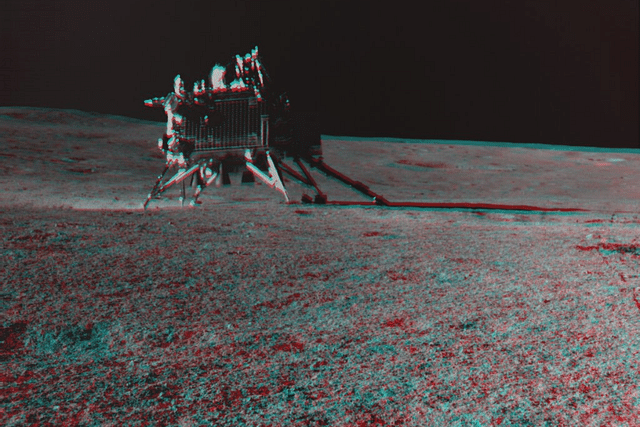News Brief
Chandrayaan-3 Rover Discovers Small Lunar Rocks, ISRO's Next Mission Can Bring Sample From Moon

Chandrayaan-3 lander on the Moon as an anaglyph
India's moon mission, Chandrayaan-3, recently had a notable encounter on the lunar surface near its landing site.
The Pragyan rover, operated by the Vikram lander, discovered small rock fragments scattered around the rim, wall slopes, and floor of small craters at the southern high-latitude landing site.
These findings could significantly advance lunar exploration, supporting previous studies that suggested a gradual coarsening of rock fragments within the lunar regolith as per a report by NDTV.
The 27-kilogram Pragyan rover, carried under the Vikram lander, was equipped with cameras and instruments to analyse the lunar soil. It also proudly displayed the ISRO logo and the Indian tricolor flag on the lunar surface.
As the rover navigated around 39 meters west of the landing site, named Shiv Shakti Point by Prime Minister Narendra Modi, the number and size of rock fragments increased. The probable source of these rock fragments is a nearly 10-meter diameter crater.
Presented earlier this year at the International Conference on Planets, Exoplanets, and Habitability in Ahmedabad, the paper proposed that this crater excavated and redistributed the rock fragments west of the landing site.
These fragments were buried multiple times by the lunar regolith overturning mechanism and eventually exposed by the small craters encountered by the Pragyan rover. Two of the rock fragments showed signs of degradation, indicating they had been subjected to space weathering.
Recently, ISRO chief S Somanath stated that with the next moon mission, Chandrayaan-4, the space agency aims to bring back a lunar sample from the 'Shiv Shakti' point.
India made history on 23 August 2023, with the Chandrayaan-3 mission, becoming the first country to land near the lunar south pole and the fourth to achieve a soft landing on the lunar surface, following the US, the former Soviet Union, and China.
Support Swarajya's 50 Ground Reports Project & Sponsor A Story
Every general election Swarajya does a 50 ground reports project.
Aimed only at serious readers and those who appreciate the nuances of political undercurrents, the project provides a sense of India's electoral landscape. As you know, these reports are produced after considerable investment of travel, time and effort on the ground.
This time too we've kicked off the project in style and have covered over 30 constituencies already. If you're someone who appreciates such work and have enjoyed our coverage please consider sponsoring a ground report for just Rs 2999 to Rs 19,999 - it goes a long way in helping us produce more quality reportage.
You can also back this project by becoming a subscriber for as little as Rs 999 - so do click on this links and choose a plan that suits you and back us.
Click below to contribute.
Latest